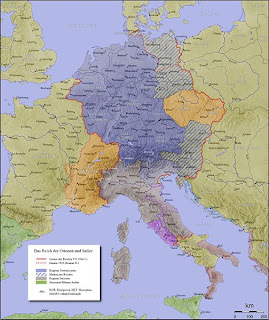As seen in my last post, the Kingdom of Prussia strongly influenced the Northern Germanic states politically and economically and later played a key role in forming the North German Confederation in 1867, thereby unifying 22 states with an estimated population of 30 million.
King Frederick William IV of Prussia; October 15, 1795
to January 2, 1861
 Flag of the North German Confederation
Flag of the North German Confederation
and later of the German Empire
 Wilhelm I, also known as Wilhelm the Great, King of Prussia from January 2, 1861 to March 9, 1888 and the first German Emperor from 18 January 1871 to March 9, 1888
Wilhelm I, also known as Wilhelm the Great, King of Prussia from January 2, 1861 to March 9, 1888 and the first German Emperor from 18 January 1871 to March 9, 1888
 Otto von Bismarck
Otto von Bismarck
to January 2, 1861
 Flag of the North German Confederation
Flag of the North German Confederationand later of the German Empire
This unification however, was unfortunately not preceded without strife. Long and drawn-out struggles between liberals who felt a unified, federal Germany using a democratic constitution to maintain a more clearly represented government against the conservatives who pressured to keep a patchwork of independent, monarchical states, resulted in a power struggle between Prussia, being the strongest and largest of the confederation, and Austria.
Another factor influencing the decision makers within Prussia was a liberal student fraternity movement striving to unify all German states as one nation. Uprisings throughout Europe, beginning with a revolutionary victory in Paris in 1848 ultimately motivated revolutions within the German states in particular.
These led to Prussia’s first constitution in 1850 and allowed for a dual housed parliament consisting of a lower house and an upper house (equivalent to the British House of Lords). Let’s do a bit of math here before continuing. The lower house was elected by taxpayers and was further divided into three classifications – the weight of the vote depended on the amount of taxes paid by the voters. Women and persons who paid no taxes were not allowed to vote! This means, approximately one-third of the voters, ultimately, wealthy men, were to choose about 85% of the parliament! A dangerous business indeed! The upper house consisted of landowning classes appointed directly by the king – the so-called Junkers, which were equivalent to British Dukes and making up the remaining 15% of the votes.
January 2, 1861 heralded the crowning of William I, also known as Wilhelm the Great with the passing of King Frederick William IV, and the beginning of a very dramatic era for the Kingdom of Prussia. With the appointment of Otto von Bismarck as Prime Minister of Prussia in 1862, the defeat of both liberal and conservative initiatives was sealed through Bismarck’s determination to create a united Germany.
 Wilhelm I, also known as Wilhelm the Great, King of Prussia from January 2, 1861 to March 9, 1888 and the first German Emperor from 18 January 1871 to March 9, 1888
Wilhelm I, also known as Wilhelm the Great, King of Prussia from January 2, 1861 to March 9, 1888 and the first German Emperor from 18 January 1871 to March 9, 1888With the domination of a Prussian ruling class and the lack of a liberal democracy, Bismarck directed Prussia through a series of wars (which I will mention in my next post) which ultimately brought King William I the dual titles of Germany’s first Emperor through the establishment of the German Empire in 1871 while remaining the King of Prussia.
 Otto von Bismarck
Otto von Bismarck






















 Buying Nobility - Noble Titles for Sale (GALLERY)
Buying Nobility - Noble Titles for Sale (GALLERY)







